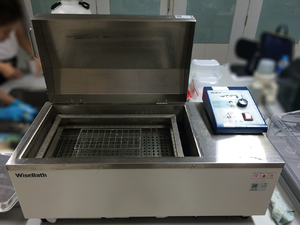Difference between revisions of "Water Bath"
| Line 29: | Line 29: | ||
:[https://www.amazon.co.uk/gp/product/1782945962/ref=as_li_tl?ie=UTF8&camp=1634&creative=6738&creativeASIN=1782945962&linkCode=as2&tag=nrjc-21&linkId=476bb5c8d1dfb5c08ac81b6d4d1c98d8 ''Water baths, page 318, GCSE Chemistry, CGP, AQA ''] | :[https://www.amazon.co.uk/gp/product/1782945962/ref=as_li_tl?ie=UTF8&camp=1634&creative=6738&creativeASIN=1782945962&linkCode=as2&tag=nrjc-21&linkId=476bb5c8d1dfb5c08ac81b6d4d1c98d8 ''Water baths, page 318, GCSE Chemistry, CGP, AQA ''] | ||
:[https://www.amazon.co.uk/gp/product/1782945954/ref=as_li_tl?ie=UTF8&camp=1634&creative=6738&creativeASIN=1782945954&linkCode=as2&tag=nrjc-21&linkId=100574c08fbbb64318256eb79ed61a76 ''Water baths, page 371, GCSE Biology, CGP, AQA ''] | :[https://www.amazon.co.uk/gp/product/1782945954/ref=as_li_tl?ie=UTF8&camp=1634&creative=6738&creativeASIN=1782945954&linkCode=as2&tag=nrjc-21&linkId=100574c08fbbb64318256eb79ed61a76 ''Water baths, page 371, GCSE Biology, CGP, AQA ''] | ||
| + | |||
| + | ====Edexcel==== | ||
| + | |||
| + | :[https://www.amazon.co.uk/gp/product/1782945725/ref=as_li_tl?ie=UTF8&camp=1634&creative=6738&creativeASIN=1782945725&linkCode=as2&tag=nrjc-21&linkId=694be7494de75af3349537d34e13f7f0 ''Water baths, page 112, GCSE Chemistry; The Revision Guide, CGP, Edexcel ''] | ||
| + | :[https://www.amazon.co.uk/gp/product/1782945741/ref=as_li_tl?ie=UTF8&camp=1634&creative=6738&creativeASIN=1782945741&linkCode=as2&tag=nrjc-21&linkId=30da4f2178da182547b62a7329d13b57 ''Water baths, page 211, GCSE Combined Science; The Revision Guide, CGP, Edexcel ''] | ||
| + | :[https://www.amazon.co.uk/gp/product/1782948120/ref=as_li_tl?ie=UTF8&camp=1634&creative=6738&creativeASIN=1782948120&linkCode=as2&tag=nrjc-21&linkId=dedef775c6a43dbb0a609441525adac0 ''Water baths, page 319, GCSE Biology, CGP, Edexcel ''] | ||
| + | :[https://www.amazon.co.uk/gp/product/1782948147/ref=as_li_tl?ie=UTF8&camp=1634&creative=6738&creativeASIN=1782948147&linkCode=as2&tag=nrjc-21&linkId=f63dcd8345f4e49c717b39a228a36c7c ''Water baths, page 326, GCSE Chemistry, CGP, Edexcel ''] | ||
Revision as of 16:58, 29 November 2019
Contents
Key Stage 3
Meaning
A water bath is a container full of water kept at a constant temperature.
About Water Baths
- Some physical and chemical changes are sensitive to temperature. When a specific temperature between 0°C and 100°C is needed then a water bath is used.
- Chemicals are not poured into a water bath but another container, such as a beaker, test tube or boiling tube are placed in the water bath.
- A water bath may have a heating element and a thermostat to keep a constant temperature
- A water bath may be some water in a large beaker which can be heated by a Bunsen Burner.
Key Stage 4
Meaning
A water bath is a container full of water kept at a constant temperature.
About Water Baths
- Some physical and chemical changes are sensitive to temperature. When a specific temperature between 0°C and 100°C is needed then a water bath is used.
- Chemicals are not poured into a water bath but another container, such as a beaker, test tube or boiling tube are placed in the water bath.
- A water bath may have a heating element and a thermostat to keep a constant temperature
- A water bath may be some water in a large beaker which can be heated by a Bunsen Burner.
References
AQA
- Water baths, page 127, GCSE Biology; The Revision Guide, CGP, AQA
- Water baths, page 238, GCSE Combined Science; The Revision Guide, CGP, AQA
- Water baths, page 240, GCSE Combined Science Trilogy; Chemistry, CGP, AQA
- Water baths, page 291, GCSE Combined Science Trilogy; Biology, CGP, AQA
- Water baths, page 318, GCSE Chemistry, CGP, AQA
- Water baths, page 371, GCSE Biology, CGP, AQA
